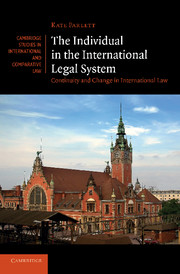Book contents
- Frontmatter
- Contents
- Foreword
- Acknowledgements
- Select list of abbreviations
- Table of cases
- Table of treaties
- Part I The Framework
- Part II The Individual in International Law
- Part III Reassessing the Framework
- 6 Reflections on the structures of the international legal system
- Bibliography
- Index
- CAMBRIDGE STUDIES IN INTERNATIONAL AND COMPARATIVE LAW
- References
6 - Reflections on the structures of the international legal system
Published online by Cambridge University Press: 19 May 2011
- Frontmatter
- Contents
- Foreword
- Acknowledgements
- Select list of abbreviations
- Table of cases
- Table of treaties
- Part I The Framework
- Part II The Individual in International Law
- Part III Reassessing the Framework
- 6 Reflections on the structures of the international legal system
- Bibliography
- Index
- CAMBRIDGE STUDIES IN INTERNATIONAL AND COMPARATIVE LAW
- References
Summary
Introduction
As has been seen, the international legal system has changed from a nineteenth century system focussed exclusively on inter-state relations to a system of law which covers a wider range of entities, including individuals. The shift from a system which conceived of individuals as mere objects to a system in which individuals have a certain status and capacity has been traced in Part II of the thesis. In each of the areas examined – international claims, humanitarian law, criminal law and human rights law – provisional conclusions have been drawn concerning the position of the individual in that particular field. It remains to draw together themes and observations about the individual in the international legal system. The second section of the chapter examines the extent to which the doctrine and practice examined in Part II reflect the orthodox accounts of the structure of the international legal system in the periods set out in Part I. The third section discusses the doctrine of subjects, engaging with critiques of the doctrine and placing the individual in terms of international legal personality. In a final section, discussion centres on what the case of the individual reveals about transition in the international legal system, and what it reveals about the position of states.
Historical development of the position of the individual in the international legal system
(a) The nineteenth century international legal system
In the nineteenth and early twentieth centuries, the established understanding of the international legal system was that its exclusive concern was relations between states, and that individuals were not subjects of, and could derive no rights or obligations directly from, international law.
- Type
- Chapter
- Information
- The Individual in the International Legal SystemContinuity and Change in International Law, pp. 343 - 372Publisher: Cambridge University PressPrint publication year: 2011

